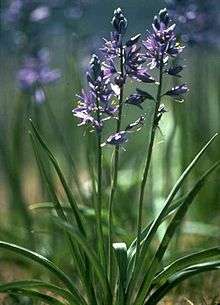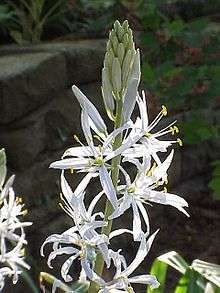Camassia
| Camassia | |
|---|---|
 | |
| Indian camas (Camassia quamash) | |
| Scientific classification | |
| Kingdom: | Plantae |
| Clade: | Angiosperms |
| Clade: | Monocots |
| Order: | Asparagales |
| Family: | Asparagaceae |
| Subfamily: | Agavoideae |
| Genus: | Camassia Lindl. |
| Type species | |
| Camassia quamash (Pursh) Greene | |
| Synonyms[1] | |

Camassia is a genus of plants in the asparagus family native to Canada and the United States. Common names include camas, quamash, Indian hyacinth, camash, and wild hyacinth.
It grows in the wild in great numbers in moist meadows; they are perennial plants with basal linear leaves measuring 8 to 32 inches (20 to 81 cm) in length, which emerge early in the spring. They grow to a height of 12 to 50 inches (30 to 127 cm), with a multi-flowered stem rising above the main plant in summer. The six-petaled flowers vary in color from pale lilac or white to deep purple or blue-violet. Camas can appear to color entire meadows when in flower.
Cultivation and uses
Camassia species were an important food staple for Native Americans and settlers in parts of the American Old West. Many areas in the Northwest are named for the plant, including Camas Valley, Oregon; the city of Camas, Washington; Lacamas Creek in southern Washington,;[2] the Camas Prairie in northern Idaho (and its Camas Prairie Railroad); and Camas County in southern Idaho.[3]
Food use
While Camassia species are edible and nutritious, the white-flowered deathcamas species (which are not in the genus Camassia but in a number of genera in the tribe Melanthieae) that grow in the same areas are toxic, and the bulbs are quite similar. It is easiest to tell the plants apart when they are in flower.
The quamash was a food source for many native peoples in the western United States and Canada. After being harvested in the autumn, once the flowers have withered, the bulbs were pit-roasted or boiled. A pit-cooked camas bulb looks and tastes something like baked sweet potato, but sweeter, and with more crystalline fibers due to the presence of inulin in the bulbs. The eating of too many such baked bulbs - especially if undercooked - can cause excessive flatulence, due to their containing inulin and other oligosaccharides.[4][5]When dried, the bulbs could be pounded into flour. Native American peoples who ate camas include the Nez Perce, Cree, Coast Salish, and Blackfoot, and Yakama among many others. The Kutenai called the camas "xapi" (Ktunaxa).[6] Camas bulbs contributed to the survival of members of the Lewis and Clark Expedition.[7]
In the Great Basin, expanded settlement by whites accompanied by turning cattle and hogs onto camas prairies greatly diminished food available to native tribes and increased tension between Native Americans and settlers and travelers.[8] Though the once-immense spreads of camas lands have diminished because of modern developments and agriculture, numerous camas prairies and marshes may still be seen today.
Ornamental use
This bulbflower naturalizes well in gardens. The bulb grows best in well-drained soil high in humus. It will grow in lightly shaded forest areas and on rocky outcrops as well as in open meadows or prairies. Additionally it is found growing alongside streams and rivers. The plants may be divided in autumn after the leaves have withered. Bulbs should be planted in the autumn. Additionally the plant spreads by seed rather than by runners.
Taxonomy and species
Historically, the genus was placed in the lily family (Liliaceae), when this was very broadly defined to include most lilioid monocots.[9] When the Liliaceae was split, in some treatments Camassia was placed in a family called Hyacinthaceae (now the subfamily Scilloideae).[10] DNA and biochemical studies have led the Angiosperm Phylogeny Group to reassign Camassia to the family Asparagaceae, subfamily Agavoideae.[11]
- Species
The World Checklist of Selected Plant Families recognizes six species as of April 2015:[1][12][13]
- Camassia angusta (Engelm. & A.Gray) Blank. - prairie camas - southern Great Plains + mid-Mississippi Valley (TX OK LA AR MO KS IA IL IN)
- Camassia cusickii S.Watson - Cusick's camas - northeastern Oregon, west-central Idaho
- Camassia howellii S.Watson - Howell's camas - southwestern Oregon
- Camassia leichtlinii (Baker) S.Watson - large camas, great camas - British Columbia, Washington, Oregon, northern + central California, Washoe County in Nevada
- Camassia quamash (Pursh) Greene - quamash, Indian camas, small camas - western Canada (BC ALB), western USA (CA OR WA NV ID MT WY UT)
- Camassia scilloides (Raf.) Cory - Atlantic camas, bear grass - eastern + Central North America from Maryland to Georgia, westward to Texas and north into Ontario.
- formerly included[1]
The name Camassia biflora was coined in 1969[14] for a South American species now known as Oziroe biflora.[15]
Synonyms
The term Camassia esculenta is a confusing one. Not an accepted name, it has been used twice, both for Camassia quamash and for Camassia scilloides. Consequently, the reference to Camassia esculenta (Ker Gawl.) B.L.Rob.[16] as a synonym for C. scilloides is deemed illegitimate,[17] while reference to Camassia esculenta (Nutt.) Lindl.[18] is a non-accepted name (synonym) for C. quamash subsp. quamash.[19] Hence the continuing horticultural usage without qualification is potentially confusing.[20]
References
- 1 2 3 World Checklist of Selected Plant Families, The Board of Trustees of the Royal Botanic Gardens, Kew, retrieved 2015-04-10
- ↑ Majors, Harry M. (1975). Exploring Washington. Van Winkle Publishing Co. p. 120. ISBN 978-0-918664-00-6.
- ↑ Idaho.gov - Camas County Archived November 20, 2011, at the Wayback Machine. - accessed 2009-06-06
- ↑ https://www.wnps.org/landscaping/documents/Common_camas.pdf
- ↑ https://www.wnps.org/blog/appreciating-common-camas/
- ↑ "FirstVoices- Ktunaxa. Plants: food plants: words.". Retrieved 2012-07-07.
- ↑ Hunter, Frances. Nearly all the men Sick: Lewis and Clark meet the Camas Root" in Frances Hunter's American Heroes Blog. Accessed 2016/3/24
- ↑ The Shoshoni Frontier and the Bear River Massacre, Brigham D. Madsen, forward by Charles S. Peterson, University of Utah Press (1985, paperback 1995), trade paperback, 286 pages, ISBN 0-87480-494-9
- ↑ Ranker, Tom A. & Hogan, Tim, Camassia, retrieved 2012-05-16, in Flora of North America Editorial Committee, ed. (1982), Flora of North America (online), eFloras.org
- ↑ Fernandez, A. & Daviña, J.R. (1991), "Heterochromatin and Genome Size in Fortunatia and Camassia (Hyacinthaceae)", Kew Bulletin, 46 (2): 307–316, doi:10.2307/4110602, JSTOR 4110602
- ↑ Stevens, P.F., Angiosperm Phylogeny Website: Asparagales: Agavoideae
- ↑ The Plant List
- ↑ Biota of North America Progran 2013 county distribution maps
- ↑ Cocucci, Alfredo Elio. 1969. Kurtziana 5: 184
- ↑ Speta, Franz. 1998. Phyton. Annales Rei Botanicae 38: 56
- ↑ Rhodora 10: 31 (1908)
- ↑ World Checklist of Selected Plant Families: Camassia esculenta (Ker Gawl.) B.L.Rob.
- ↑ Edwards's Bot. Reg. 18: t. 1486 (1832)
- ↑ World Checklist of Selected Plant Families: Camassia esculenta (Nutt.) Lindl.
- ↑ Dig Drop Done
Further reading
- Brisland, Richard T. W. Camas processing or upland hunting : an interpretation of lithic scatters at High Prairie. Calgary, Alb.: University of Calgary, 1992. Thesis (M.A.)
- Comber, Harold F.; Miller, Murray. Check list of the plants of the Camassia Natural Area : vascular plants. [Oregon]: Oregon Chapter, The Nature Conservancy, 1967
- Coville, Frederick V. (1897). The technical name of the camas plant. Proceedings of the Biological Society of Washington 11: 61-65.
- Gould, Frank W. A systematic treatment of the genus Camassia Lindl. Notre Dame, Ind.: University Press, 1942.
- Konlande, J. E.; Robson, John R. (1972). The nutritive value of cooked camas as consumed by Flathead Indians. Ecology of food and nutrition 2: 193-195.
- Maclay, Anne M. Studies of the life history of Camassia quamash (Pursh) Greene. Pullman, Wash., State College of Washington (Washington State University), 1928. Thesis (M.S.)
- Rice, Peter M.; Toney, J. Chris.; Cross, Marcia Pablo. Rehabilitation of camas and bitterroot gathering sites: study plan. [Hamilton, Mont: Bitterroot National Forest: U.S. Forest Service], 1996.
- Smith, Harriet L. Camas: the plant that caused wars. Lake Oswego, Or.: Smith, Smith and Smith Pub. Co., 1978.
- Stevens, Michelle L. and Darris, Dale C. Plant Guide for Common Camas: Ethnobotany, Culture, Management, and Use. Plant Materials Technical Note No. 25. (June 16, 2000) U.S. Department of Agriculture Natural Resources Conservation Service, Portland, Oregon, 2000.
- Stevens, Michelle L. and Darris, Dale C. Ethnobotany, Culture and Use of Great Camas (Camassia quamash ssp. quamash). Plant Materials Technical Note No. 23 (September 1999). U.S. Department of Agriculture Natural Resources Conservation Service, Portland, Oregon, 1999
- Storm, Linda. Patterns and Processes of Indigenous Burning 2000
- Statham, Dawn Stram. Camas and the Northern Shoshoni: a biogeographic and socioeconomic analysis. Boise, Idaho: Boise State University, 1982.
- Thoms, Alston V. The northern roots of hunter-gatherer intensification: camas and the Pacific Northwest. Pullman, Wash.: Thesis (Ph. D.)--Washington State University, 1989.
- Toney, J. Chris. Traditional plant restoration: restoration of camas & bitterroot gathering sites (phase I-year 1 progress report). [Hamilton, Mont: Bitterroot National Forest: U.S. Forest Service], 1997
External links
- Camassia from Flora of North America
- Camas Meadows at Washington State University
- Camassia Natural Area (Oregon) - Nature Conservancy
- Camassia Slopes Preserve (North Carolina)- Nature Conservancy
- Camas Prairie in Idaho from the National Park Service
- Camassia from the Washington Department of Transportation
- Native Plants of the Great Lakes from the U.S. EPA
- Southeastern Rare Plant Information Network - SERPIN
- Camassia from the Native Plant Information Network
| Wikimedia Commons has media related to Camassia. |
| Wikispecies has information related to: Camassia |
| Look up camassia in Wiktionary, the free dictionary. |